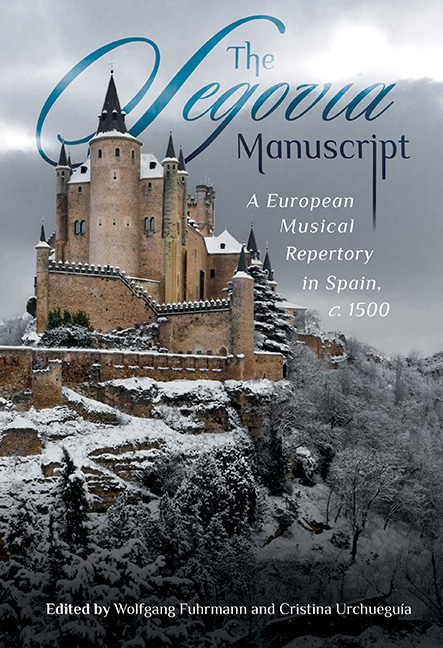Book contents
- Frontmatter
- Contents
- List of Illustrations
- Notes on Contributors
- Abbreviations
- Preambulum: A Source in Segovia
- 1 In Search of Origins: The Afterlife of a Renaissance Manuscript
- 2 New Light on the Segovia Manuscript: Watermarks, Foliation, and Ownership
- 3 Segovia's Repertoire: Attributions and Datings (with Special Reference to Jacob Obrecht)
- 4 What Was Segovia For?
- 5 The Latin Texts of the Segovia Manuscript
- 6 The Segovia Manuscript as Chansonnier
- 7 The Segovia Manuscript: Another Look at the ‘Flemish Hypothesis’
- 8 The Segovia Manuscript: Speculative Notes on the Flemish Connection
- 9 The Written Transmission of Polyphonic Song in Spain c. 1500: The Case of the Segovia Manuscript
- 10 Inventory of Segovia, Archivo Capitular de la Catedral, MS s.s.
- Bibliography
- Index of Compositions
- General Index
- Miscellaneous Endmatter
5 - The Latin Texts of the Segovia Manuscript
Published online by Cambridge University Press: 29 March 2020
- Frontmatter
- Contents
- List of Illustrations
- Notes on Contributors
- Abbreviations
- Preambulum: A Source in Segovia
- 1 In Search of Origins: The Afterlife of a Renaissance Manuscript
- 2 New Light on the Segovia Manuscript: Watermarks, Foliation, and Ownership
- 3 Segovia's Repertoire: Attributions and Datings (with Special Reference to Jacob Obrecht)
- 4 What Was Segovia For?
- 5 The Latin Texts of the Segovia Manuscript
- 6 The Segovia Manuscript as Chansonnier
- 7 The Segovia Manuscript: Another Look at the ‘Flemish Hypothesis’
- 8 The Segovia Manuscript: Speculative Notes on the Flemish Connection
- 9 The Written Transmission of Polyphonic Song in Spain c. 1500: The Case of the Segovia Manuscript
- 10 Inventory of Segovia, Archivo Capitular de la Catedral, MS s.s.
- Bibliography
- Index of Compositions
- General Index
- Miscellaneous Endmatter
Summary
An examination of Obrecht's Latin-texted motet Inter preclarissimas virtutes conducted for the 2005 conference on him in Antwerp found that the Segovia manuscript exhibited errors not attributable to the author and omissions not required by the setting. It therefore seemed appropriate to survey the other Latin texts.
In masses, we are not surprised when words are selectively underlaid, as they are in the Isaac mass at the beginning; but in Josquin's Missa L'homme armé sexti toni there is nearly a full texting, presumably because the source had it. To the scribe's credit be it noted that throughout the early mass section ‘Kyrie eleyson’ and ‘Christe eleyson’ are written with their full complement of es, contrary to (for instance) some Cappella Sistina manuscripts; though later, in Agricola's mass beginning on fol. 135r, we find ‘Leyson’ five times and ‘eleyson’ four.
Still, our man could underlay the mass text in his sleep, and sometimes did: on fol. 57v (Plate 5.1), in the superius of the Credo of Pipelare's first Missa sine nomine – the one shared with Jena 32 – after ‘deum verum de deo vero’ he first wrote ‘genitum non factum’, which is the next phrase of the Niceno- Constantinopolitan Creed, then crossed it out when he discovered that in that voice Pipelare, not fearing any recrudescence of the Arian heresies, had skipped over both this phrase and ‘consubstantialem Patri’ to ‘per quem omnia facta sunt’. Likewise unrevealing are the Salve regina and Magnificat texts that follow the masses; it is original Latin that is significant.
The first piece of this nature is Obrecht's Inter preclarissimas virtutes (excerpt 1), whose transmission is very far from being amongst the most illustrious virtues of this manuscript. Not only are there verbal differences between the voices, but the text in several places needs emendation; Albert Smijers made a good start, on which I have attempted to advance.
- Type
- Chapter
- Information
- The Segovia ManuscriptA European Musical Repertory in Spain, c.1500, pp. 145 - 166Publisher: Boydell & BrewerPrint publication year: 2019

